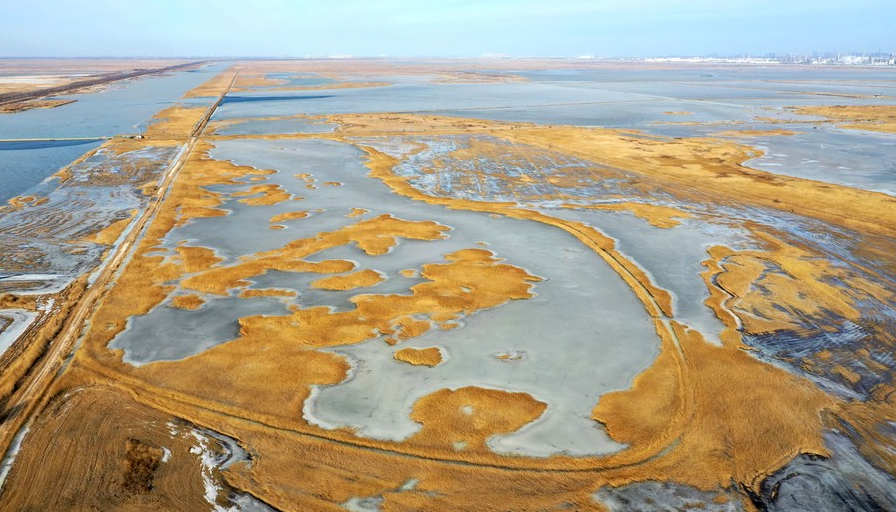Fruits of wetland restoration efforts blossom in Tianjin

This aerial photo taken on Feb. 1, 2023 shows the view of Beidagang Wetland in north China's Tianjin. (Xinhua/Zhao Zishuo)
On a crisp winter day, more than 20 elks were sighted wandering the lush Qilihai wetland in the Ninghe District of north China's Tianjin Municipality, as the serene setting of this vast wetland was enlivened by the graceful presence of these magnificent creatures.
"Since 2021, we have steadfastly continued our efforts to release elks into the wild in the Qilihai wetland. Over the past two years, the released elks have not only thrived in their habitat but also gave birth to four little elks," said Wu Chengyi, an official with Qilihai Wetland Nature Reserve.
This development serves as a clear indication that the ecological function of the Qilihai wetland is gradually being restored, creating a sustainable and thriving environment for its inhabitants.
In 2017, Tianjin launched a wetland protection campaign to restore the ecological environment in 875 square kilometers of its wetland nature reserves including Beidagang, Qilihai and Dahuangpu.
"The restoration efforts underway at the Qilihai wetland are centered around 10 critical projects, including water diversion and storage, reed restoration and bird protection," said Wu, adding that nearly 1,067 hectares of wetland vegetation have been restored in Qilihai.
In Tianjin's Beidagang wetland, adjacent to Bohai Bay, the revitalization of the ecological environment makes it a popular stopover site for various migratory birds, including some new species that have recently made their appearance.
"The oriental white stork is an endangered bird and picky about its habitat environment. In China, they tend to breed in the northeastern region of the country," said Sun Hongyi, a staffer at the Beidagang wetland nature reserve management center.
However, more than 60 pairs of oriental white storks have been spotted nesting and breeding in the Beidagang wetland in recent years."This shows that the aquatic environment and biodiversity of the Beidagang wetland have improved significantly," Sun added.
Oriental white storks as well as the number of other migratory birds are increasing in the reserve. Even in the frigid winter, some migratory birds are reluctant to leave, Sun added.
To better serve the"guests" from afar, Beidagang wetland not only undertakes regular patrol and monitoring but also uses artificial floating islands and other means to speed up the restoration of aquatic plants and create a premium stopover habitat for migratory birds.
In addition to the thriving bird population in Beidagang, a growing number of birds are being spotted throughout Tianjin, with the city's avian diversity increasing from 416 species to 452 species, as reported by official statistics.
Moreover, the picturesque wetlands not only offer immeasurable benefits to the bird populations, but they also contribute to enhancing people's well-being.
The Chaobai River National Wetland Park in the Baodi District of Tianjin is quickly gaining popularity as a favorable spot for running, exercise and leisure activities.
"The wetland park is close to the Chaobai New River and is a veritable oasis of natural beauty, offering an abundance of blooming flowers, thriving bird populations and pristine air," said Sun Yan, a local resident, adding that doing exercise in the park has become an important part of her retirement life.
At present, the total area of wetlands in Tianjin stands at 2,956 square kilometers and the protection rate of wetlands in the city exceeds 59 percent, said Guo Xiumin, an official with the Tianjin Municipal Bureau of Planning and Natural Resources.
"Tianjin has established a wetland natural protection system, with wetland nature reserves as its foundation, which is supplemented by wetland parks and marine parks. The beautiful vision of harmonious coexistence between humans and wetlands is becoming a reality," Guo added.
 京公網安備 11010802027341號
京公網安備 11010802027341號